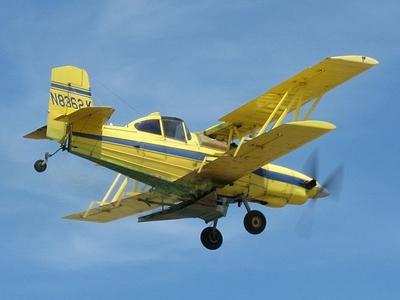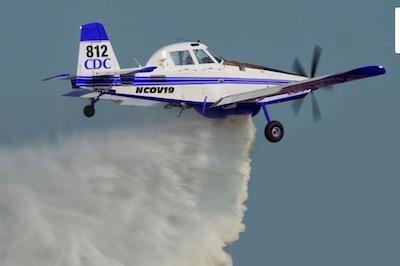Fri, Aug 05, 2022
Voluntary NAAA C-PAASS Program Launching in 2023
Aircraft have been plied to agricultural purposes for almost one-hundred years. That crop-dusting remains a statistically dangerous line of work despite advances in aerospace technology and an ever-expanding galaxy of regulations is a paradoxical anomaly within an industry otherwise grown increasingly safe. Whilst the worldwide accident rate of commercial aviation has improved by eighty-percent over the last decade, agricultural operations across North America alone average five accidents per month.

In 2017 0.02% of Agricultural (AG) pilots had fatal accidents—compared to a fatal accident rate of 0.003% among GA pilots. The same year, over forty-thousand people perished in U.S. car accidents—a figure representing a fatality risk roughly equal to that of crop-dusting.
For purpose of bettering the safety of agricultural flying, the National Agricultural Aviation Association (NAAA) is launching its Certified-Professional Aerial Applicator Safety Steward (C-PAASS) program in 2023. The voluntary program will allow aerial-applicators (crop-duster pilots) who strive to constantly educate themselves to better their flying safety and the accuracy and efficiency of their applications to be recognized for their efforts.
Agricultural pilots seeking to earn C-PAASS designation during the program’s 2023 inaugural year will need jump through the following hoops—with additional hoops forthcoming:
- Annual Membership in NAAA (2023).
- Annual Membership in a state or regional agricultural aviation association (2023).
- Annual PAASS (Professional Aerial-Applicators’ Support System) attendance (three out of the past three years: 2022-2023 season, 2021-2022 season, 2020-2021 season).
- Biennial Operation S.A.F.E. (Self-regulating Application and Flight Efficiency) participation (one out of the last two years, or both: 2022 and/or 2023).
Operation S.A.F.E. fly-in clinics offer aerial-applicators opportunity to verify the accuracy of their aircraft onboard delivery systems to ensure precise application of chemical agents—thereby safeguarding the investments of growers and the safety of the general public.
In 2024, an online learning management system (LMS) will become part of C-PAASS. LMS content will be based on previous PAASS modules and sessions offered at NAAA’s annual Ag Aviation Expo.
C-PAASS certification is offered solely to agricultural pilots and will need be renewed annually. The initial annual cost of certification is $100. Operating companies will not be certified, but may advertise their pilots as being so.

The initial program certification requirements are based on education and professional opportunities currently available to all agricultural aviators. The National Agricultural Aviation Research and Education Foundation’s (NAAREF) PAASS Program has a record of reducing agricultural aircraft accidents and drift incidents (the undesirable drifting of aerially-applied pesticides or fertilizers from areas of intended delivery). Five-years after the PAASS Program’s 1998 debut, the agricultural industry saw drift incidents decrease by 26%. Since the program’s inception, the instance of fatal aircraft accidents within the agricultural industry has dropped by ten-percent. The reductions in both drift incidents and fatal aircraft accidents occurred with only 47% of U.S. agricultural aviation operators and pilots participating in the PAASS Program.
More News
Also: 787-Billion Pax, Ryanair Buying Chinese, Ballooning HoF, ERAU MX Competition An NTSB Preliminary report is shedding some light on the Rob Holland tragedy. And there now seems>[...]
Also: Tricky Golf Course Deadstick, Textron Special Olympics, Artemis II, FlightSimExpo! Stratolaunch conducted the second successful launch and recovery of its Talon-A2 autonomous>[...]
Also: Rotax Service Instruction, LAA Jabiru Alert, New AMA Boss, FlightSimExpo ANN’s Jim Campbell got an hour in the SLEEK Blackshape Prime last week along with a chance to w>[...]
“Secretary Duffy’s plan cements America as a global leader in aviation, investing in both technology and the air traffic control workforce to enhance U.S. aviation safe>[...]
Witnesses Described That The Glider Pitched Up Before Entering A Nose Low, Left Descending Turn Analysis: The 84-year-old pilot was being towed for takeoff in his glider when the a>[...]
 Airborne 05.05.25: NTSB Holland Prelim, Airlines v Tariffs, $$$ For ATC
Airborne 05.05.25: NTSB Holland Prelim, Airlines v Tariffs, $$$ For ATC Airborne 05.07.25: Talon A-2 Hypersonic, FIFI Under Repair, Spirit Furloughs
Airborne 05.07.25: Talon A-2 Hypersonic, FIFI Under Repair, Spirit Furloughs Airborne Affordable Flyers 05.08.25: Blackshape Test, Risen, Alto NG Sells Out
Airborne Affordable Flyers 05.08.25: Blackshape Test, Risen, Alto NG Sells Out Aero-News: Quote of the Day (05.11.25)
Aero-News: Quote of the Day (05.11.25) NTSB Final Report: Schleicher Alexander GMBH & CO ASH 26 E
NTSB Final Report: Schleicher Alexander GMBH & CO ASH 26 E




